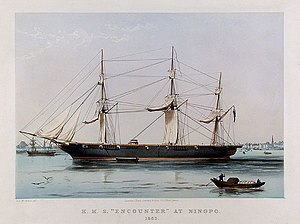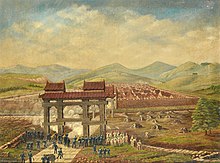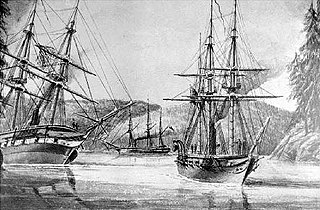
HMS Plumper was part of the 1847 Program, she was ordered on the 25 of April as a steam schooner from Woolwich Dockyard with the name Pincher. However, the reference Ships of the Royal Navy, by J.J. College, (c) 2020 there is no entry that associates this name to this build. The vessel was reordered on August 12 as an 8-gun sloop as designed by John Fincham, Master Shipwright at Portsmouth. Launched in 1848, she served three commissions, firstly on the West Indies and North American Station, then on the West Africa Station and finally in the Pacific Station. It was during her last commission as a survey ship that she left her most enduring legacy; in charting the west coast of British Columbia she left her name and those of her ship's company scattered across the charts of the region. She paid off for the last time in 1861 and was finally sold for breaking up in 1865.
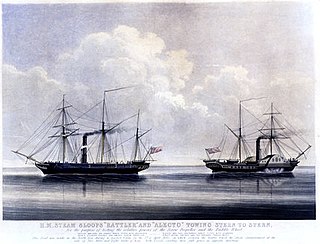
HMS Rattler was a 9-gun steam screw sloop of the Royal Navy, and one of the first British warships to be completed with screw propulsion. She was originally ordered as a paddle wheel 4-gun steam vessel from Sheerness Dockyard on 12 March 1841. She was reordered on 24 February 1842 as a propeller type 9-gun sloop from HM Royal Dockyard, Sheerness, as a new vessel. William Symonds had redesigned the ship as a screw propeller driven vessel.

HMS Miranda was a 14-gun wooden screw sloop of the Royal Navy. As part of the 1847 Program, she was designed by John Fincham, Master Shipwright of Portsmouth and is considered an improved Rattler with the design approved on 3 November 1847. She was ordered on the 25th of April 1847 with the name Grinder from Royal Dockyard, Sheerness. On the 3rd of November 1847 she was reordered as the Miranda from Sheerness Dockyard. Launched in 1851, she was completed to see action in the Russian War of 1854 - 55. In 1854 she was in the White Sea and participated in the bombardment of the Port of Kola. She then participated in the Sea of Azov during 1855. Two of her crew were awarded the Victoria Cross for their bravery. Towards the end of her career she transported troops during the New Zealand war. She was reclassified as a corvette by 1862, She was sold for breaking in December 1869.

HMS Captain was a 70-gun third rate built at Woolwich Dockyard in 1677/78. After sitting in Ordinary for ten years she was in active commission for the War of the English Succession fighting at Beachy Head and Barfleur. She was in Ordinary until 1706 when she was rebuilt. She was in active commission for the last half of the War of Spanish Succession but fought in no major engagements. She was at the Battle of Passero I 1718. She was rebuilt in 1720/22. She made two forays in to the Baltic though the bulk of her late career was spent as guardship at Portsmouth. She was hulked in 1740 and finally broken in 1762.

HMS Lenox was a 70-gun third rate built at Deptford Dockyard in 1677/78. She was inactive commission for the War of English Succession fighting in the Battles of Beachy Head and Barfleur. She was rebuilt in 1699. Again in active commission for the War of Spanish Succession fighting in the Capture of Gibraltar and the Battle of Velez Malaga. She followed this with the Battle off Passero. She was rebuilt again in 1721. She was active in the War with Spain, capturing the Princesa then serving in Home Waters, the Mediterranean and finally the West Indies. She was in action off Havana in 1745. She returned home and was placed in Ordinary. She was finally sunk as a breakwater at Sheerness in 1756.
HMS Berwick was a 70-gun third rate ship of the line of the Royal Navy, built at Chatham Dockyard during 1677/1679. After completion she was placed in Ordinary for 10 years. She was commissioned for the War of the English Succession 1689-1697, participating in the battles of Beachy Head and Barfleur. She was rebuilt between 1697 and 1700. She was commissioned for the War of Spanish Succession 1702-1712, participating in the battles of Vigo Bay, Capture of Gibraltar and Velez Malaga. placed in Ordinary in 1712, she was converted to a hulk at Portsmouth in 1715 before being broken in 1742.
HMS Burford was a 70-gun third rate ship of the line built at Woolwich Dockyard in 1677/79 as part of the Thirty Ships Programme of 1677. She fought in the War of the English Succession, including the Battle of Barfleur, before being rebuilt at Deptford in 1699, remaining as a 70-gun third rate. During the War of Spanish Succession she was mostly in the Mediterranean fleet and fought at the capture of Gibraltar and the Battle of Málaga in 1704 before being extensively repaired between 1710 and 1712 at Portsmouth Dockyard. Burford served in the Baltic in 1715 and 1717 before returning to the Mediterranean to fight the Spanish at the Battle of Cape Passaro in 1718. She was wrecked on the Italian coast in a storm on 14 February 1719.

HMS Eagle was a 70-gun third rate ship of the line of the Royal Navy, builtat Portsmouth Dockyard during 1677/79. When completed she was placed in Ordinary for 10 years. She was in active commission during the War of the English Succession partaking in the Battle of Barfleur. She was rebuilt in 1699 at Chatham. She again played an active role in the early part of the War of Spanish Succession participating in the Capture of Gibraltar, and the Battle of Velez Malaga. She was wrecked in the Isles of Scilly in October 1707.
HMS Elizabeth was a 70-gun third rate built at Barnards Yard at Deptford Green by William and Robert Castle of Rotherhithe in 1678/80. She held an active commission during the War of the English Succession fighting in all three major engagements. She was rebuilt at Portsmouth between 1699 and 1704. She was captured by the French off the Scilly Islands in November 1704. She was in the French Navy until she was deleted in 1720.

HMS Expedition was a 70-gun third-rate ship of the line built at Portsmouth Dockyard in 1677/79. She was in active commission during the War of the English Succession participating in the battles of Beachy Head and Barfleur. She was rebuilt in 1699. Again, for the War of Spanish Succession she was in commission for the operation at Cadiz then returned to England where she sat for two years. She was in the Mediterranean for the Battle of Marbella in 1705. She then went to the West Indies and fought in Wager’s action off Cartagena in 1708. She was rebuilt in 1709-14 to the 1706 Establishment. She spent her time split between the Baltic and as guard ship at Portsmouth before being broken at Portsmouth in 1736. She was rebuilt in 1736/40 at Deptford Dockyard.

HMS Niger was originally slated to be built as a Sampson designed sloop; however, she was ordered as a First-Class sloop with screw propulsion on 20 February 1845 to be built at Woolwich Dockyard, along the design developed by Oliver Lang and with a hull like the Basilisk designed paddle sloops. Her armament and engine were to be like the Encounter Design building at Pembroke. A second vessel (Florentia) was ordered on 26 March 1846 but after her keel was laid at Pembroke Dockyard, her construction was suspended on 6 October 1846 then cancelled three years later, on 22 May 1849. Niger She conducted important propulsion trials, finally proving the superiority of screw propulsion and served in West Africa, the Crimea, China, the East Indies and Australia. She took part in the New Zealand wars in 1860 and was sold for breaking in 1869.
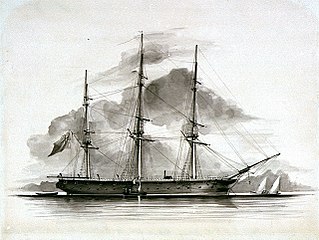
HMS Brisk was a 14-gun wooden-hulled screw sloop designed by the Committee of Reference as part of the 1847 program. She is considered an enlarged Rattler with the design approved in 1847. She was ordered on 25 April 1847 from Woolwich Dockyard as a 10-gun sloop, but the guns were later increased due to the Russian War, to 14 guns by increasing the number of 32-pounder guns. She was launched on 2 June 1851 from Woolwich Dockyard. She served in the Russian War of 1854- 55 and as part of the West African anti-slavery patrol, with a final commission on the Australian Station. She was sold in 1870 into mercantile service.

HMS Barracouta was the last paddle sloop built for the Royal Navy. She was built at Pembroke Dockyard and launched in 1851. She served in the Pacific theatre of the Crimean War, in the Second Opium War and in the Anglo-Ashanti wars. She paid off for the last time in 1877 and was broken up in 1881.

This group of vessels were originally slated to be built to the Sampson designed steam vessel; however, the Admiralty on 9 May 1845, ordered the first pair as First-Class screw sloops to be built from a design of Sir William Symonds, Surveyor of the Navy. This design would become known as the Conflict-class sloop. These would be 10-gun vessels with 400 NHP engines. The second pair of vessels were ordered on 26 March 1846 but after their keels were laid at Pembroke Dockyard, their construction was suspended in September 1846 then cancelled five years later, on 4 April 1851. Both completed ships served in the Baltic during the Crimean war, and Desperate briefly served as a store ship to Edward Augustus Inglefield's Arctic expedition. They had both been broken up by 1865.

HMS Reynard was part of the 1847 Program, she was ordered on 25 April as a steam schooner from Deptford Dockyard with the name ‘Plumper’. However, the reference Ships of the Royal Navy, by J.J. College, © 2020, there is no entry that associates the name Plumper to this build. The vessel was reordered on August 12th as an 8-gun sloop as designed by John Edye. She was launched in 1848, conducted anti-piracy work in Chinese waters and was wrecked near Pratas Island in the South China Sea on 31 May 1851.

On 26 March 1846, two vessels were ordered from Deptford Dockyard as Rifleman-designed gunvessels named Archer and Parthian. However, on 9 September 1846 the orders for both vessels were suspended prior to the vessels being laid down. On 25 April 1847 two vessels were ordered to the improved Rattler-type screw sloops as designed by John Edye of the Surveyor's Department from Deptford Dockyard. The first vessel, Archer may have been the change of the build from the Rifleman type to the sloop design. The second vessel, Wasp, appears to be a new vessel as the build for the Parthian remained on the books at Deptford until June 1849, when it was cancelled. Archer received the machinery from the gunvessel Rifleman, which resulted in an increase of speed over Wasp. Wasp's hull was sheathed in Muntz metal to retard marine growth. Their armament would increase from 12 to 15 guns over their careers. Both vessels would participate in the Russian War of 1854–1855. Both would be broken by 1869.

HMS Dee was the first paddle steamer ordered for the Royal Navy, designed to carry a significant armament. She was ordered on 4 April 1827 from Woolwich Dockyard. She was designed by Sir Robert Seppings, Surveyor of the Navy and modified by Oliver Lang. This vessel was considered as new construction as a previous vessel ordered as a flush deck Cherokee-class brig in 1824, had been renamed African in May 1825. She was initially classed as a steam vessel (SV), and in 1837 reclassified as a steam vessel class 2 (SV2). She was converted to a troopship in May 1842 and as a second class sloop in 1846. She was converted into a storeship in 1868. She was broken at Sheerness in 1871.
HMS Rhadamanthus was one of the initial steam powered vessels built for the Royal Navy. On 10 January 1831 the First Sea Lord gave orders that four paddle vessels be built to competitive designs. The vessels were to be powered by Maudslay, Son & Field steam engines, carry a schooner rig and mount one or two 10-inch shell guns. Initially classed simply as a steam vessel (SV), she was re-classed as a second-class steam sloop in 1846. Designed by Thomas Roberts, the Master Shipwright of Plymouth. She was launched and completed in 1832, She was converted into a transport in 1841 then in 1851 she was a troopship and by the 1860s she was a transport again. Her breaking was completed in February 1864.
HMS Medea was one of the initial steam-powered vessels built for the Royal Navy. On 10 January 1831 the new First Lord Sir James Graham gave orders that four paddle vessels be built to competitive designs. The vessels were to be powered by Maudslay, Son & Field steam engines, carry a schooner rig and mount one or two 10-inch shell guns. Initially classed simply as a steam vessel (SV), she was re-classed as a second-class steam sloop when that categorization was introduced on 31 May 1844. Designed by Oliver Lang, the master shipwright of Woolwich. She was launched and completed in 1834, took part in the Syrian Coast Campaign and was broken up in 1867.
The Stromboli class was a group of two vessels designed by Sir William Symonds the Surveyor of the Navy. The design was approved on 29 August 1838. The vessels were of the Medea design but were altered to the new draught derived from the Gorgon. The ships were initially classified as Steam Vessels Second Class (SV2) and were later classified as First Class sloops. The ships were built in two Royal Dockyards. Both ships were at the bombardment of Acre in 1840. Both were in the Black and Azov seas during the Russian War. They served on various stations of the Empire. Vesuvius was sold in 1865 and Stromboli in 1866. Both were broken by White at East Cowes on the Isle of Wight.
